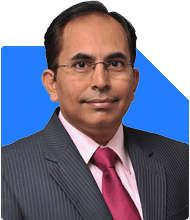36-Year-Old Mother Seeks Investment Advice for Monthly Income and Child Education
Ramalingam Kalirajan |10902 Answers |Ask -Follow
Mutual Funds, Financial Planning Expert - Answered on Nov 26, 2024
He has an MBA in finance from the University of Madras and is a certified financial planner.
He is the director and chief financial planner at Holistic Investment, a Chennai-based firm that offers financial planning and wealth management advice.... more
.jpg)
Hello I am 36 years old female having a 2 year old toddler. I am not able to resume any work due to family responsibilities.however I have inherited almost a corpus of 80 lacs from parents which I need to invest for monthly income of 1 lac approx while saving the capital.my husband is working and earns 40 k per month after household expenses and basic term and health insurance we aren't left with any corpus for future expense like child education retirement corpus etc.kindly guide.
Understanding Cash Flow Issues
You have a structured budget with Rs. 75,000 as your EMI, Rs. 30,000 in SIPs, Rs. 10,000 in LIC, and Rs. 15,000 for home expenses. This leaves you with Rs. 30,000. However, the lack of liquid cash at month-end signals an imbalance.
Three factors need attention:
High EMI compared to income
Lack of emergency savings
Minimal liquidity for unforeseen expenses
Let us address each systematically.
Reassessing the Home Loan EMI
Rs. 75,000 EMI forms nearly 47% of your income. Ideally, this should be below 30%.
Contact your lender to extend the loan tenure. This will reduce EMI and ease your cash flow.
Check for refinancing options with lower interest rates. Even a small reduction in interest rates will lower the EMI significantly.
Optimising SIP Contributions
Rs. 30,000 in SIPs is commendable. It reflects your commitment to long-term wealth creation.
However, assess the funds’ performance regularly.
Consider temporarily reducing SIP contributions to Rs. 20,000 until your cash flow improves. Once your financial situation stabilises, increase the amount gradually.
Evaluating the LIC Policy
Check if your LIC policy is purely insurance or investment-cum-insurance.
If it is an investment-cum-insurance policy, evaluate its returns and coverage.
Consider surrendering low-return policies and reinvesting the surrender value into mutual funds through a certified financial planner (CFP).
Building an Emergency Fund
An emergency fund should cover at least six months of expenses.
Allocate Rs. 5,000 monthly towards building this fund.
Use a high-yield savings account or liquid mutual fund for easy access.
Streamlining Monthly Expenses
Home expenses of Rs. 15,000 seem reasonable.
Review discretionary expenses such as dining out or subscriptions.
Implement cost-saving measures, such as cooking at home or choosing economical alternatives.
Boosting Monthly Savings
Automate your savings to ensure consistency.
After revising your SIPs and reducing EMI, direct surplus income to a recurring deposit.
A recurring deposit will instil discipline and grow liquidity.
Strategising for Your Daughter’s Future
At 14, her higher education costs are imminent. Start a dedicated fund for this purpose.
Invest in a balanced mutual fund with a horizon of four to five years.
Reassess the fund's allocation annually as the education expense nears.
Retirement Planning
Your current focus is understandably on immediate needs.
Once cash flow improves, allocate Rs. 5,000 monthly for retirement in a retirement-focused mutual fund.
Begin this once your emergency fund is in place.
Avoiding Common Financial Pitfalls
Do not borrow for non-essential expenses.
Avoid policies or investments with high charges and low returns.
Stay insured with adequate health and term insurance coverage.
Regular Review and Adjustment
Revisit your financial plan every six months.
Seek advice from a certified financial planner to optimise investments and tax savings.
Adjust your strategy as your income grows or expenses change.
Finally
Your current efforts show dedication to financial stability. By rebalancing EMI, SIPs, and building liquidity, you will improve cash flow significantly. Stay consistent with disciplined savings, and your future financial goals will be secure.
Best Regards,
K. Ramalingam, MBA, CFP,
Chief Financial Planner,
www.holisticinvestment.in
https://www.youtube.com/@HolisticInvestment
You may like to see similar questions and answers below
Ramalingam Kalirajan |10902 Answers |Ask -Follow
Mutual Funds, Financial Planning Expert - Answered on May 17, 2024
Ramalingam Kalirajan |10902 Answers |Ask -Follow
Mutual Funds, Financial Planning Expert - Answered on Dec 17, 2025
Janak Patel |72 Answers |Ask -Follow
MF, PF Expert - Answered on Dec 17, 2025
Samraat Jadhav |2514 Answers |Ask -Follow
Stock Market Expert - Answered on Dec 18, 2025
Reetika Sharma |432 Answers |Ask -Follow
Financial Planner, MF and Insurance Expert - Answered on Dec 18, 2025
Reetika Sharma |432 Answers |Ask -Follow
Financial Planner, MF and Insurance Expert - Answered on Dec 18, 2025
Reetika Sharma |432 Answers |Ask -Follow
Financial Planner, MF and Insurance Expert - Answered on Dec 18, 2025
Samraat Jadhav |2514 Answers |Ask -Follow
Stock Market Expert - Answered on Dec 18, 2025

Kanchan Rai |648 Answers |Ask -Follow
Relationships Expert, Mind Coach - Answered on Dec 18, 2025
Kanchan Rai |648 Answers |Ask -Follow
Relationships Expert, Mind Coach - Answered on Dec 18, 2025
Anu Krishna |1754 Answers |Ask -Follow
Relationships Expert, Mind Coach - Answered on Dec 18, 2025
Anu Krishna |1754 Answers |Ask -Follow
Relationships Expert, Mind Coach - Answered on Dec 18, 2025
Anu Krishna |1754 Answers |Ask -Follow
Relationships Expert, Mind Coach - Answered on Dec 18, 2025

























